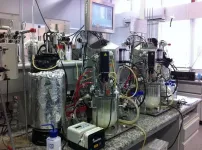(Press-News.org) American Geophysical Union
Press Release 23-11
27 March 2023
For Immediate Release
This press release is available online at: https://news.agu.org/press-release/the-greenland-ice-sheet-is-close-to-a-melting-point-of-no-return/
AGU press contact:
Rebecca Dzombak, +1 (202) 777-7492, news@agu.org (UTC-4 hours)
Contact information for the researchers:
Dennis Höning, Potsdam Institute for Climate Impact Research, dennis.hoening@pik-potsdam.de (UTC+1 hour)
WASHINGTON — The Greenland Ice Sheet covers 1.7 million square kilometers (660,200 square miles) in the Arctic. If it melts entirely, global sea level would rise about 7 meters (23 feet), but scientists aren’t sure how quickly the ice sheet could melt. Modeling tipping points, which are critical thresholds where a system behavior irreversibly changes, helps researchers find out when that melt might occur.
Based in part on carbon emissions, a new study using simulations identified two tipping points for the Greenland Ice Sheet: releasing 1000 gigatons of carbon into the atmosphere will cause the southern portion of the ice sheet to melt; about 2500 gigatons of carbon means permanent loss of nearly the entire ice sheet.
Having emitted about 500 gigatons of carbon, we’re about halfway to the first tipping point.
“The first tipping point is not far from today’s climate conditions, so we’re in danger of crossing it,” said Dennis Höning, a climate scientist at the Potsdam Institute for Climate Impact Research who led the study. “Once we start sliding, we will fall off this cliff and cannot climb back up.”
The study was published in AGU’s journal Geophysical Research Letters, which publishes short-format, high-impact research spanning the Earth and space sciences.
The Greenland Ice Sheet is already melting; between 2003 and 2016, it lost about 255 gigatons (billions of tons) of ice each year. Much of the melt to date has been in the southern part of the ice sheet. Air and water temperature, ocean currents, precipitation and other factors all determine how quickly the ice sheet melts and where it loses ice.
The complexity of how those factors influence each other, along with the long timescales scientists need to consider for melting an ice sheet of this size, make it difficult to predict how the ice sheet will respond to different climate and carbon emissions scenarios.
Previous research identified global warming of between 1 degree to 3 degrees Celsius (1.8 to 5.4 degrees Fahrenheit) as the threshold beyond which the Greenland Ice Sheet will melt irreversibly.
To more comprehensively model how the ice sheet’s response to climate could evolve over time, Höning’s new study for the first time used a complex model of the whole Earth system, which includes all the key climate feedback processes, paired with a model of ice sheet behavior. They first used simulations with constant temperatures to find equilibrium states of the ice sheet, or points where ice loss equaled ice gain. Then they ran a set of 20,000-year-long simulations with carbon emissions ranging from 0 to 4000 gigatons of carbon.
From among those simulations, the researchers derived the 1000-gigaton carbon tipping point for the melting of the southern portion of the ice sheet and the even more perilous 2,500-gigaton carbon tipping point for the disappearance of nearly the entire ice sheet.
As the ice sheet melts, its surface will be at ever-lower elevations, exposed to warmer air temperatures. Warmer air temperatures accelerate melt, making it drop and warm further. Global air temperatures have to remain elevated for hundreds of years or even longer for this feedback loop to become effective; a quick blip of 2 degrees Celsius (3.6 degrees Fahrenheit) wouldn’t trigger it, Höning said. But once the ice crosses the threshold, it would inevitably continue to melt. Even if atmospheric carbon dioxide were reduced to pre-industrial levels, it wouldn’t be enough to allow the ice sheet to regrow substantially.
“We cannot continue carbon emissions at the same rate for much longer without risking crossing the tipping points,” Höning said. “Most of the ice sheet melting won’t occur in the next decade, but it won’t be too long before we will not be able to work against it anymore.”
###
AGU (www.agu.org) is a global community supporting more than half a million advocates and professionals in Earth and space sciences. Through broad and inclusive partnerships, AGU aims to advance discovery and solution science that accelerate knowledge and create solutions that are ethical, unbiased and respectful of communities and their values. Our programs include serving as a scholarly publisher, convening virtual and in-person events and providing career support. We live our values in everything we do, such as our net zero energy renovated building in Washington, D.C. and our Ethics and Equity Center, which fosters a diverse and inclusive geoscience community to ensure responsible conduct.
*****
Notes for journalists:
This paper is published in Geophysical Research Letters, a fully open-access journal. View and download a pdf of the study here.
Paper title:
“Multistability and transient response of the Greenland Ice Sheet to anthropogenic CO2 emissions”
Authors:
Dennis Höning (corresponding author), Matteo Willeit, Reinhard Calov, Andrey Ganopolski, Potsdam-Institute for Climate Impact Research, Potsdam, Germany
Volker Klemann, Meike Bagge, GFZ German Research Centre for Geosciences, Department of Geodesy, Potsdam, Germany END
New simulation combines emissions with weather and chemistry in an air-quality model
First neighborhood-scale simulation of its kind focused on Chicago tracks air quality hour by hour across areas as small as 1.3 kilometers-sized blocks
Simulation can show how pollutants move across space and time throughout the city and surrounding areas
Air pollution along highways is consistently worse than other areas, regardless of season or time of day
EVANSTON, Ill. — If you live along one of the major interstate highways running through Chicago or directly next to Lake Michigan, you are regularly exposed to more air pollution than ...
TAMPA, Fla. – Immunotherapies have greatly improved the outcomes of many patients with melanoma. But there is still a need for new approaches for the subset of patients who do not respond well to this type of therapy. Moffitt Cancer Center researchers are looking at new targets to help inhibit tumor development and promote antitumor immunity, one being the STING signaling pathway. In a new article published in Nature Communications, a team of Moffitt and University of Miami Miller School of Medicine investigators demonstrate that targeting the STING pathway with a combination strategy ...
In addition to an antigen, many vaccines also contain substances, called adjuvants, which stimulate the immune system. By using computer-aided molecular design and machine learning, a Chinese research team has now developed two novel broad-spectrum adjuvants that can significantly amplify the immune response to vaccines. As reported in the journal Angewandte Chemie, they were able to enhance the effectiveness of immunization against certain forms of cancer in animal models.
Adjuvants amplify and prolong the effect of vaccine immunizations. Aluminum salts have been successfully used ...
ITHACA, N.Y. – An international team of astronomers has found the atmospheric compositions of giant planets out in the galaxy do not fit our own solar system trend.
Using NASA’s James Webb Space Telescope (JWST), the researchers discovered that the atmosphere of exoplanet HD149026b, a ‘hot Jupiter’ orbiting a star comparable to our sun, is super-abundant in the heavier elements carbon and oxygen – far above what scientists would expect for a planet of its mass.
These findings, published in “High atmospheric metal enrichment for a Saturn-mass ...
When studying the brain, researchers are just beginning to use a method known as voltage imaging to track neural activity in the living animal. While this approach is a promising way to better understand neuron firing, behavior, and cognition, there are limitations and risk factors. The practice requires putting a lot of light into the brain (which can lead to overheating) and only has the capacity to image ten neurons at a time.
New research from Jerry Chen, a Boston University College of Arts & Sciences assistant professor of biology, and collaborators aims to address these challenges. Published today in Nature Methods, ...
Researchers at Rochester Institute of Technology are investigating the combined physical effects of heat, chemical reactions, and seismic activity on concrete lining structures used to dispose of nuclear waste. Results from the work could improve nuclear waste infrastructure designs, better long-term safety management, and refine strategies to meet climate change targets.
Lu Sun, a professor in RIT’s College of Engineering Technology (CET), received a grant of nearly $500,000 from the Nuclear Regulatory Commission for “High temperature and seismic response of concrete lining structures and clay in nuclear waste disposal.” ...
An international team of researchers has used NASA’s James Webb Space Telescope to measure the temperature of the rocky exoplanet TRAPPIST-1 b. The measurement is based on the planet’s thermal emission: heat energy given off in the form of infrared light detected by Webb’s Mid-Infrared Instrument (MIRI). The result indicates that the planet’s dayside has a temperature of about 500 kelvins (roughly 450 degrees Fahrenheit) and suggests that it has no significant atmosphere.
This is the first detection of any form of light emitted by an exoplanet as small and as cool as the rocky planets in our own solar system. The result ...
Providing an overview of the submissions process and examples of U.S. Food and Drug Administration (FDA) applications for Orphan Drug Designation (ODD) and Rare Pediatric Disease Designation (RPDD), a new article can help developers of gene therapies for rare genetic diseases. The article is published in the peer-reviewed journal Human Gene Therapy. Click here to read the article now.
Anne Pariser and Elizabeth Ottinger, from the National Center for Advances in Translational Sciences (NCATS), National Institutes of Health, and coauthors, describe the ODD and RPDD programs, which provide financial incentives for the development of ...
A Brazilian study paves the way to increased efficiency of second-generation (2G) ethanol production based on the discovery of novel targets for metabolic engineering in a more robust strain of industrial yeast. An article on the study is published in the journal Scientific Reports.
The databases compiled by the authors are at the disposal of the scientific community in the repository of the State University of Campinas (UNICAMP), which is a member of the Dataverse Project, an international collaborative initiative supported by FAPESP.
First-generation (1G) ethanol is produced from sources rich in carbohydrates ...
UC Davis Health and Propeller Health have announced a new collaboration that will offer personalized treatment for high-risk patients with asthma and chronic obstructive pulmonary disease (COPD) aiming to improve their health outcomes.
As part of the collaboration, UC Davis Health will provide the Propeller program – including sensors, mobile app, web portal, and personalized support – to eligible patients, with eventual expansion to patients in other UC locations and UC affiliates. The sensors attach to a patient’s inhaler to capture unique signals that record events, such as ...




